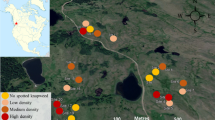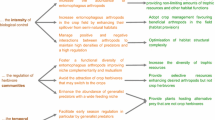Abstract
Many studies have found positive relationships between plant diversity and arthropod communities, but the interactive effects of plant genetic diversity and environmental stress on arthropods are not well documented. In this study, we investigated the consequences of plant genotypic diversity, watering treatment, and its interaction for the ground-dwelling arthropod community in an experimental common garden of quaking aspen (Populus tremuloides Michx.). We found that varying plant genotypic diversity and watering treatment altered multivariate arthropod community composition and structure. Arthropod biodiversity and richness showed a distinct response to the plant diversity × watering treatment interaction, declining sharply in water-limited genotypic mixtures. Abundance of arthropod functional groups did not show any response to diversity or the plant diversity × watering treatment interaction, but varied in their response to watering treatment, with predator and detritivore abundance increasing and parasitoid abundance decreasing in well-watered blocks. Our results conflict with most previous studies, and suggest that environmental stress can substantially change the nature of the plant-arthropod diversity relationship. Additionally, we suggest that the plant-arthropod diversity relationship is dependent on the type of plant and arthropod species sampled, and that the association between tree diversity and ground-dwelling arthropods may be much different than more commonly studied grassland species and herbivorous arthropods.

Similar content being viewed by others
References
Anderson MJ (2001) A new method for non-parametric multivariate analysis of variance. Aust Ecol 26:32–46. doi:10.1046/j.1442-9993.2001.01070.x
Andow DA (1991) Vegetational diversity and arthropod population response. Annu Rev Entomol 36:561–586. doi:10.1146/annurev.en.36.010191.003021
Armitage PD (1995) Behavior and ecology of adults. In: Armitage PD, Cranston PS, Pinder LCV (eds) The Chironomidae: biology and ecology of non-biting midges. Chapman & Hall, London, pp 194–224
Bangert RK, Turek RJ, Rehill BJ, Wimp GM, Schweitzer JA, Allan GJ et al (2006) A genetic similarity rule determines arthropod community structure. Mol Ecol 15:1379–1391. doi:10.1111/j.1365-294X.2005.02749.x
Callaway RM, Brocker RW, Choler P, Zaal K, Lortie CJ, Michalet R et al (2002) Positive interactions among plants increase with stress. Nature 417:844–848. doi:10.1038/nature00812
Crutsinger GM, Collins MD, Fordyce JA, Gompert Z, Nice CC, Sanders NJ (2006) Plant genotypic diversity predicts community structure and governs an ecosystem process. Science 313:966–968. doi:10.1126/science.1128326
Farquhar GD, Richards RA (1984) Carbon isotope discrimination and photosynthesis. Aust J Plant Physiol 11:539–552
Floate KD, Whitham TG (1994) Insects as traits in plant systematics: their use in discriminating between hybrid cottonwoods. Can J Bot 73:1–13. doi:10.1139/b95-001
Gardner SM, Cabido MR, Valladares GR, Diaz S (1995) The influence of habitat structure on arthropod diversity in Argentine semi-arid Chaco forest. J Veg Sci 6:349–356. doi:10.2307/3236234
Haddad NM, Tilman D, Haarstad J, Ritchie M, Knops JMH (2001) Contrasting effects of plant richness and composition on insect communities: a field experiment. Am Nat 158:17–35. doi:10.1086/320866
Hochwender GG, Fritz RS (2004) Plant genetic differences influence herbivore community structure: evidence from a hybrid willow system. Oecologia 138:547–557. doi:10.1007/s00442-003-1472-4
Hooper DU, Chapin FSIII, Ewel JJ, Hector A, Inchausti P, Lavorel S et al (2005) Effects of biodiversity on ecosystem functioning: a consensus of current knowledge. Ecol Monogr 75:3–35. doi:10.1890/04-0922
Hwang S-Y, Lindroth RL (1997) Clonal variation in foliar chemistry of aspen: effects on gypsy moths and forest tent caterpillars. Oecologia 111:99–108. doi:10.1007/s004420050213
Johnson MTJ, Agrawal AA (2005) Plant genotype and environment interact to shape a diverse arthropod community on evening primrose (Oenothera biennis). Ecology 86:874–885. doi:10.1890/04-1068
Johnson MTJ, Lajeunesse MJ, Agrawal AA (2006) Additive and interactive effects of plant genotypic diversity on arthropod communities and plant fitness. Ecol Lett 9:24–34
Kanaga MK, Ryel RJ, Mock KM, Pfrender ME (2008) Quantitative-genetic variation in morphological and physiological traits within a quaking aspen (Populus tremuloides) population. Can J Res 38:1690–1694. doi:10.1139/X08-012
Knops JMH, Tilman D, Haddad NM, Naeem S, Mitchell CE, Haarstad J et al (1999) Effects of plant species richness on invasion dynamics, disease outbreaks, insect abundances and diversity. Ecol Lett 2:286–293. doi:10.1046/j.1461-0248.1999.00083.x
Koricheva J, Larsson S, Haukioja E (1998) Insect performance on experimentally stressed woody plants: a meta-analysis. Annu Rev Entomol 43:195–216. doi:10.1146/annurev.ento.43.1.195
Koricheva J, Mulder CPH, Schmid B, Joshi J, Huss-Danell K (2000) Numerical responses of different trophic groups of invertebrates to manipulations of plant diversity in grasslands. Oecologia 125:271–282. doi:10.1007/s004420000450
Lawton JH (1983) Plant architecture and the diversity of phytophagous insects. Annu Rev Entomol 28:23–39. doi:10.1146/annurev.en.28.010183.000323
Lindroth RL, Kinney KK, Platz CL (1993) Responses of deciduous trees to elevated atmospheric CO2: productivity, phytochemistry and insect performance. Ecology 74:763–777. doi:10.2307/1940804
McArdle BH, Anderson IC (2001) Fitting multivariate models to community data: a comment on distance-based redundancy analysis. Ecology 82:290–297
Murdoch W, Evans F, Peterson C (1972) Diversity and pattern in plants and insects. Ecology 53:819–829. doi:10.2307/1934297
Oksanen J, Kindt R, Legendre P, O’Hara B, Simpson GL, Stevens MHH et al (2008) Vegan: community ecology package. R package version 2.7.1
Perner J, Wytrykush C, Kahmen A, Buchmann N, Egerer S, Creutzburg S et al (2005) Effects of plant diversity, plant productivity and habitat parameters on arthropod abundance in montane European grasslands. Ecography 28:429–442. doi:10.1111/j.0906-7590.2005.04119.x
Porter LJ, Hrstich LN, Chan BG (1986) The conversion of procyanidins and prodelphinidins to cyanidin and delphinidin. Phytochem 25:223–230. doi:10.1016/S0031-9422(00)94533-3
Priesser EL, Strong DR (2004) Climate affects predator control of an herbivore outbreak. Am Nat 163:754–762. doi:10.1086/383620
Reusch TBH, Ehlers A, Hammerli A, Worm B (2005) Ecosystem recovery after climatic extremes enhanced by genotypic diversity. Proc Natl Acad Sci USA 102:2826–2831. doi:10.1073/pnas.0500008102
SAS Institute (2003) SAS version 9.1. Cary, NC
Scherer-Lorenzen M, Schulze E-D, Don A, Schumacher J, Weller E (2007) Exploring the functional significance of forest diversity: a new long-term experiment with temperate tree species (BIOTREE). Perspect Plant Ecol Evol Syst 9:53–70. doi:10.1016/j.ppees.2007.08.002
Schowalter TD, Lightfoot DC, Whitford WG (1999) Diversity of arthropod responses to host-plant water stress in a desert ecosystem in southern New Mexico. Am Midl Nat 142:281–290. doi:10.1674/0003-0031(1999)142[0281:DOARTH]2.0.CO;2
Siemann E (1998) Experimental tests of effects of plant productivity and diversity on grassland arthropod diversity. Ecology 79:2057–2070
Siemann E, Tilman D, Haarstad J, Ritchie M (1998) Experimental tests of the dependence of arthropod diversity on plant diversity. Am Nat 152:738–750. doi:10.1086/286204
Southwood TRE (1978) Ecological methods. Chapman & Hall, London
Southwood TRE, Brown VK, Reader PM (1979) The relationships of plant and insect diversities in succession. Biol J Linn Soc Lond 12:327–348. doi:10.1111/j.1095-8312.1979.tb00063.x
Stevens MT, Waller DM, Lindroth RL (2007) Resistance and tolerance in Populus tremuloides: genetic variation, costs, and environmental dependency. Evol Ecol 21:829–847. doi:10.1007/s10682-006-9154-4
Tews J, Brose U, Grimm V, Tielborger K, Wichmann MC, Schwager M et al (2004) Animal species diversity driven by habitat heterogeneity/diversity: the importance of keystone structures. J Biogeogr 31:79–92
Tilman D (1996) Biodiversity: population versus ecosystem stability. Ecology 77:350–363. doi:10.2307/2265614
Tilman D, Downing JA (1994) Biodiversity and stability in grasslands. Nature 367:363–365. doi:10.1038/367363a0
Trotter RT, Cobb NS, Whitham TG (2008) Arthropod community diversity and trophic structure: a comparison between extremes of plant stress. Ecol Entomol 33:1–11
Vehvilainen H, Koricheva J, Ruohomaki K (2007) Tree species diversity influences herbivore abundance and damage: meta-analysis of long-term forest experiments. Oecologia 152:287–298. doi:10.1007/s00442-007-0673-7
Vehvilainen H, Koricheva J, Ruohomaki K (2008) Effects of stand tree species composition and diversity on abundance of predatory arthropods. Oikos 117:935–943. doi:10.1111/j.0030-1299.2008.15972.x
Wenninger EJ, Inouye RS (2008) Insect community response to plant diversity and productivity in a sagebrush-steppe ecosystem. J Arid Environ 72:24–33. doi:10.1016/j.jaridenv.2007.04.005
Wimp GM, Young WP, Woolbright SA, Martinsen GD, Keim P, Whitham TG (2004) Conserving plant genetic diversity for dependent animal communities. Ecol Lett 7:776–780. doi:10.1111/j.1461-0248.2004.00635.x
Wimp GM, Martinsen GD, Floate KD, Bangert RK, Whitham TG (2005) Plant genetic determinants of arthropod community structure and diversity. Evolution 59:61–69
Wimp GM, Wooley S, Bangert RK, Young WP, Martinsen GD, Keim P et al (2007) Plant genetics predict intra-annual variation in phytochemistry and arthropod community structure. Mol Ecol 16:5057–5069. doi:10.1111/j.1365-294X.2007.03544.x
Yachi S, Loreau M (1999) Biodiversity and ecosystem productivity in a fluctuating environment: the insurance hypothesis. Proc Natl Acad Sci USA 96:1463–1468. doi:10.1073/pnas.96.4.1463
Acknowledgments
Thanks to Mary Pendergast for assistance in the design and implementation of this study, Ryan Shaw for aspen root collection, the USFS Rocky Mountain Research Station for greenhouse space, and the Utah State University (USU) College of Natural Resources for common garden space. Thanks to Kennedy Rubert III for conducting chemical analyses, and M. Ernest, T. Evans, and the USU evolution reading group for comments on the manuscript. This work was funded by a graduate research grant and graduate fellowship from the USU Ecology Center to M. Kanaga; the Utah Agricultural Research Station, USFS Rocky Mountain Research Station, USDA UV Monitoring Program, USDA National Resources Conservation Service and USU VP for Research to R. Ryel; the USU Community University Research Initiative and ADVANCE Program to K. Mock; and NSF grant DEB-0344019 to R. Lindroth.
Author information
Authors and Affiliations
Corresponding author
Additional information
Handling Editor: Stanislav Gorb.
Rights and permissions
About this article
Cite this article
Kanaga, M.K., Latta, L.C., Mock, K.E. et al. Plant genotypic diversity and environmental stress interact to negatively affect arthropod community diversity. Arthropod-Plant Interactions 3, 249–258 (2009). https://doi.org/10.1007/s11829-009-9073-8
Received:
Accepted:
Published:
Issue Date:
DOI: https://doi.org/10.1007/s11829-009-9073-8




